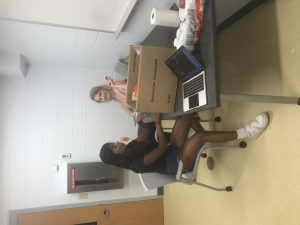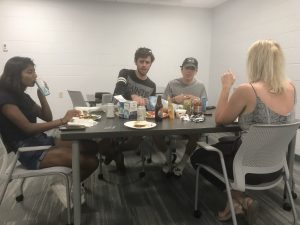My name is Dominic Lal and I am currently a sophomore at Emory University studying Psychology with a minor in predictive health. I am living in Cincinnati for the summer because I managed to get a sweet internship working for Children’s Cincinnati, so I am living with 3 other roommates who have completely different stories and aspirations. My background is quite unique as I am half African American and half Indian (Gujarati), which has directly impacted my relationship to food. Specifically I have a preference towards spicier foods with burst of flavor combinations (Takis) rather than one type of flavor that is stronger (Lays Original Potato Chips) as a result of the numerous Indian dishes that revolve around having countless succulent ingredients working in harmony. I have always been drawn to learning more about people and what makes them tick, hence the psychology major, so this class and its focus on social anthropology sparked my interest. In Gillian Crowther’s book Eating Culture she describes social anthropology as the study of the everyday lives of ordinary people, anywhere, and food is a constant so which led me to explore the process of how college students cook in a communal setting (Crowther, XVII). Being a college student has allowed me to gain experience cooking in a communal setting individually as well as with my peers. Personally I do not enjoy cooking communally because of the inherent dirty dishes and tables that may accompany trusting college students to keep an open area clean. I have learned about the differences that occur between cooking with family as opposed to being in a place where you don’t have access to everything you would at home.
One night this summer, I was sitting around the table in my dorm living room eating with my 2 roommates (the ones whose company I actually enjoy) when I thought about the string of events that had to occur in all of our lives to bring us together at this one blacktop rectangular “table” which more so resembles a desk. It is definitely a nontraditional kitchen table which is reflective of the environment I am currently location: Xavier university where the tools for cooking are limited. This table interests me because of its ability to bring countless people together throughout the years of being at Xavier university and the style of table is pretty universal across all college campuses. The most interesting feature of these tables are the wheels that allow for extreme mobility. This mobility represents the lives of so many college students that have to pack up their lives and move locations during the spring, fall, and summer intersessions. Chapter Five of Porta Palazzo described the relationship between migration and food that spoke wonders to the struggles of a college student on the move. “Food is something most migrants hold dear; it helps maintain relations in kin groups, strengthens ties to home, and is often deeply linked to memory”(Black, 94). This quote brings to mind the days prior to going back to visit home, in which I start to salivate at the thought of being able to go home and eat my Ba’s (grandmothers) home cooked Saak and Rotli and the importance that food holds to people who are away from home because there is an outlet to remain connected to those who are physically far. I personally feel comforted and safe when eating or thinking about classic Gujarati food made at home and eaten around our old school wooden kitchen table with 4 6 wooden chairs to match.

I used participant observation as my main anthropological method because I believe that first hand observation can be extremely valuable as they allow one to learn about the unconscious and less obvious practices of the usage of kitchen tables. I believe both informal interviews and participant observation are important and vital to understanding this research to the fullest potential however for this short 2 page blog post using a more directed research approach for a more in depth analysis of the table seemed to be more efficient and reasonable. Working hands on has always been more appealing to me as I learn the most from action and is also important for understanding culinary tradition and culture among people (and yes…college cooking is a culture that is filled with adaptable meals like instant pasta with sausage and random meats) (Crowther, XXI).
The first part of the research was the participant observation in which I studied my roommates and some friends throughout the food gathering, preparation, cooking, and cleaning process. The first part of this process was going to Jungle Jims, a local favorite when it comes to grocery stores, and we bought ground beef, onions, tomatoes, limes, cilantro, Mexican cheese, sour cream, and tortillas in order to create decadent soft tacos. We arrived to the enormous store at 4:30 on Sunday and then proceeded to walk around the outskirts of the store and then meandered into the middle of the store and picked up miscellaneous items like drinks on our journey. It is important to note that the items were split on all parties involved in the culinary adventure as some friends were responsible for buying beef, others cheese and sour cream, etc. I believe the division of responsibility made cooking a more inclusive environment in which everyone literally and metaphorically brought something to the table.
A speaker was placed on the kitchen table and music was played throughout the cooking process with bops ranging from “Crank That” by soulja boy to “Old Town Road” by Lil Nas X. I personally found this to be super cool as the kitchen table was used to house music, as many college students listen to music while eating/making food. I observed the cooking process in depth as each person in the kitchen has a different role. Laurens role was to cut the tomatoes, lime, cilantro, and onions, which was done on the black rectangular kitchen table. While Lauren was cutting Andrew, Sam, and I focused on defrosting the meat and cooking it thoroughly with the onions. Susanna’s role was to heat up the tortillas and keep the aux (music playing). Cooking went on all throughout the kitchen, however the central location was the kitchen table that gracefully carried all of the ingredients on it. It was an unspoken rule that the kitchen table was supposed to remain organized and clean throughout the process of cooking, where people would constantly take time to wipe of the runaway vegetables that fell off plates. I also found in interesting that there were times in which all the cooking ceased and everyone circled up around the kitchen table to sing a song that was played as a bonding moment. These were my favorite memories as I felt emotions of happiness, peace, and belonging because despite the varying backgrounds everyone seemed to be on the same page.

The clean multipurpose kitchen table which housed music, random cooking supplies, the food, and cool people.

Susanna eating some of the tomatoes during the meal prep stage.
Following the meal prep stage of the study was my personal favorite, the eating and cleaning process in which we all sat around the table spaced out perfectly to leave room for everyone to remain comfortable while maintaining a sort of closeness among the group. The table housed a variety of different foods as we had numerous plates laid out with vegetables, tortillas, chips, dip, and drinks for a self serve taco construction. I personally stuck with a classic taco with ground beef, salsa, cheese, tomatoes, and a hint of my own red masala for a mouthwatering combination of flavors. It was amazing and I loved how I was able to add in my own ingredient of masala in the perfect quantity without pushing that flavor onto the whole group. Following the demolition of 2 pounds of ground beef and about 15 tortillas, we started the cleaning process in which Lysol spray was used on the table followed by a quick wipe down of the surface to leave the blacktop with a shiny gleam.

When food is not being consumed or created using the kitchen table, it is typically occupied by my roommates and I as we all work on different task ranging from resume edits, making flashcards, sending emails, preparing for work presentations together. Even though food is not present there is still an aspect of communal working on the table that I find particularly interesting. Whenever I am working with them I always feel at ease and apart of a group which makes the task seem less daunting and thus easier as well.
At the start of the study I did not appreciate the idea of communal cooking, however this project has allowed me to understand the importance of cooking as a community. I typically cook my food alone, however during the participant observation section of the study I had so much fun being able to prepare a meal with people from different backgrounds. Being able to share stories about our past and learn from each other’s strengths and weaknesses was an amazing experience that I would gladly partake in on a regular basis. We have actually decided to make this newfound experience of buying groceries and cooking together a Sunday tradition for the rest of the summer J. This directly relates to the idea of eating “family style” similar to what we discussed in class with having many international families eating together as a means to build bonds and love among a family. I learned that even when one is away from family, they can still find family and that is very comforting for me as I have never been away from home for this long.
In conclusion the basic rolling table that most can find in college dormitories serve a vital role in bringing together people from all different walks of life, similar to what it has done for Andrew, Sam, and I this summer. I appreciate its versatility as it can be used before meals for prepping ingredients, during meals as a host for numerous people (more chairs can be rolled to the table depending on the number of guests), and after meals as a communal working space. Tables are a lot more intricate than they seem and I love how this table in particular shows a striking resemblance to the mobile life of college students who are constantly moving locations.

Dominic, thanks for such a detailed study on the migrating kitchen table. I can see the effort you’ve made in making this post successful. You’ve addressed the five prompt questions fairly well in your essay, especially the first four questions. Comparing to the other parts of your paper, the conclusion feels weak, particularly because I believe you could be more articulate and explicit about your discoveries. The other main area you’ve lost some points is “connection-making” (per the evaluation rubric)–you might be able to make some stronger connections between our class discussions/course materials and your experience this summer. On the whole, you’ve done a good job!